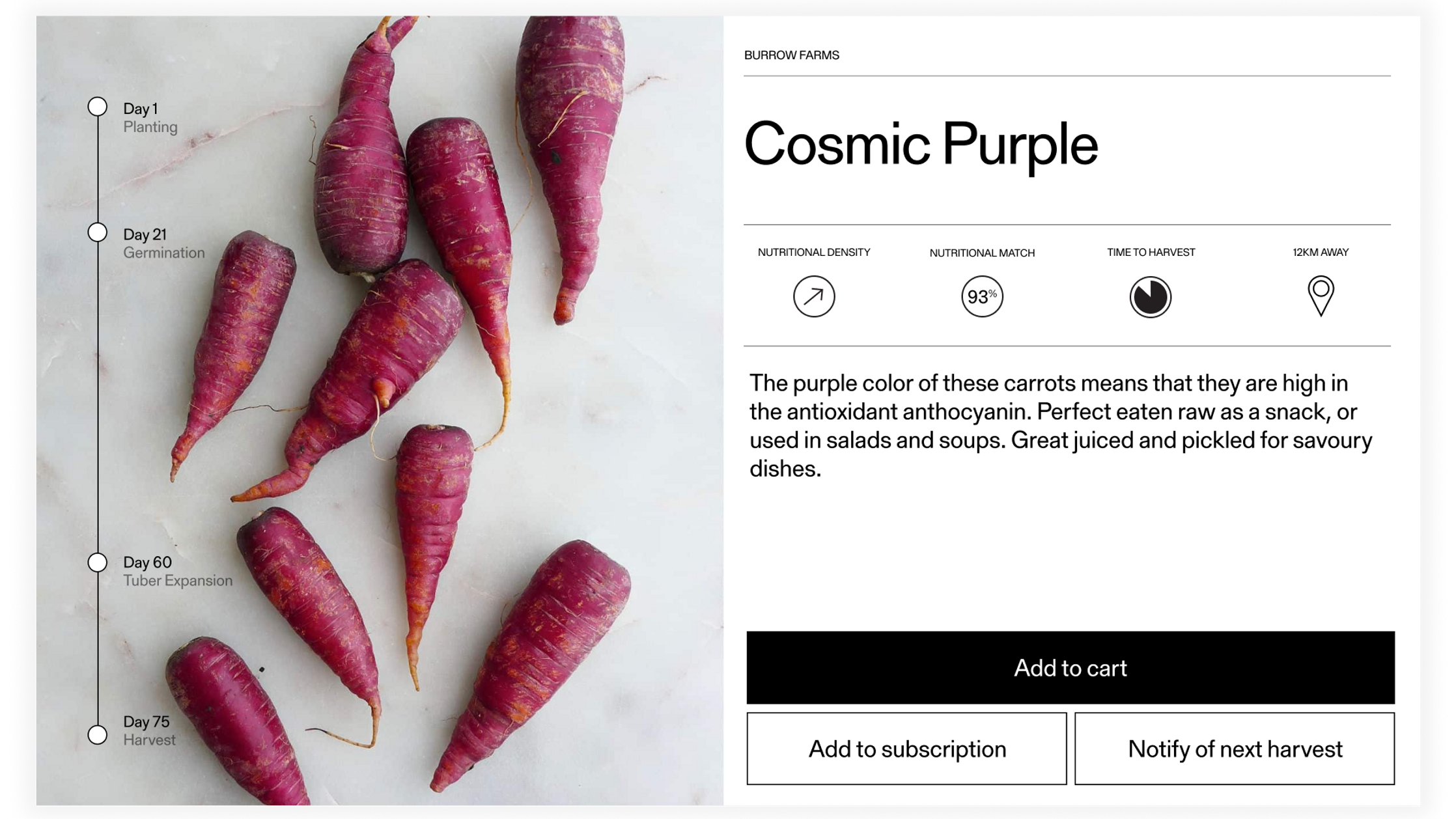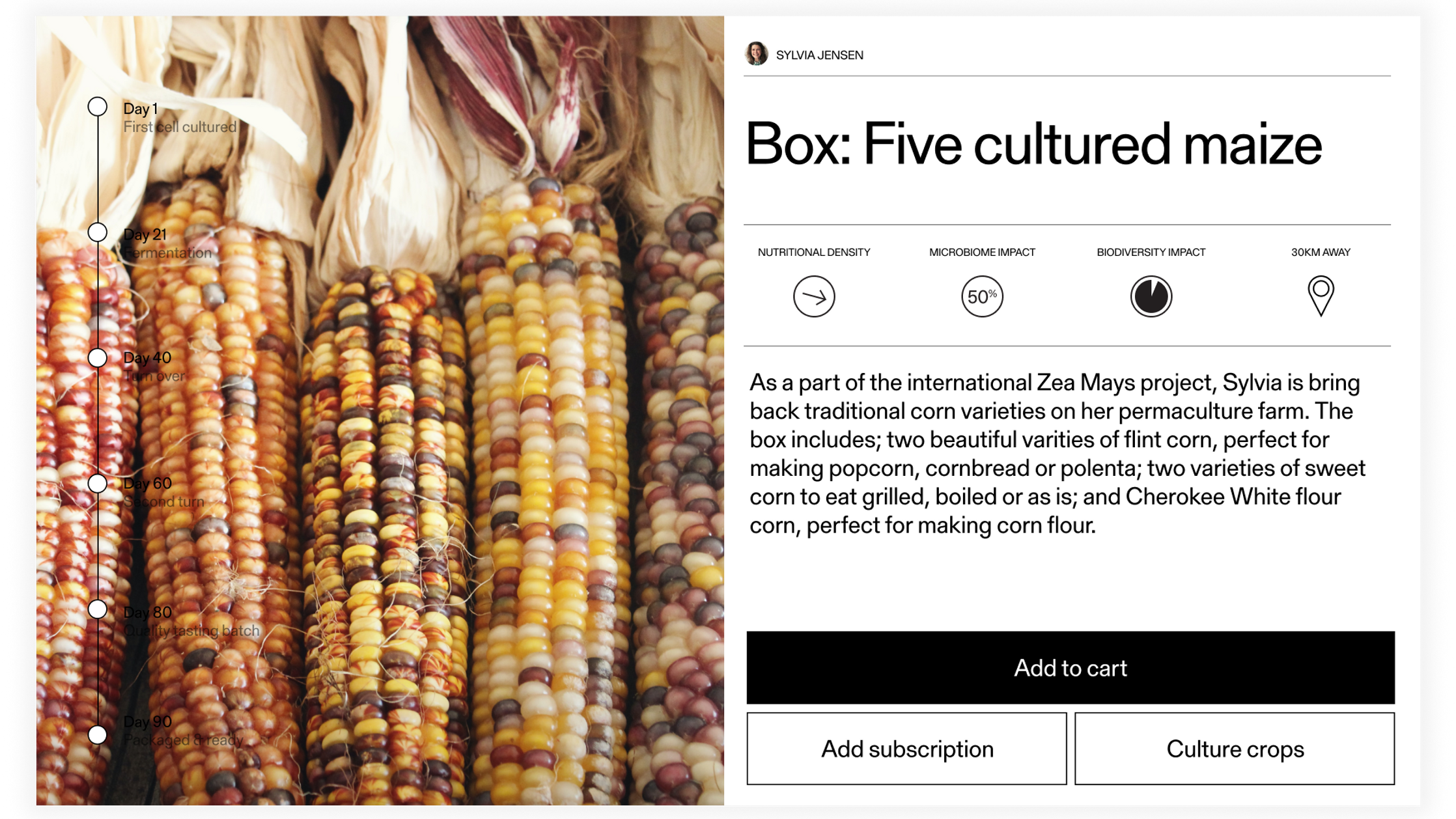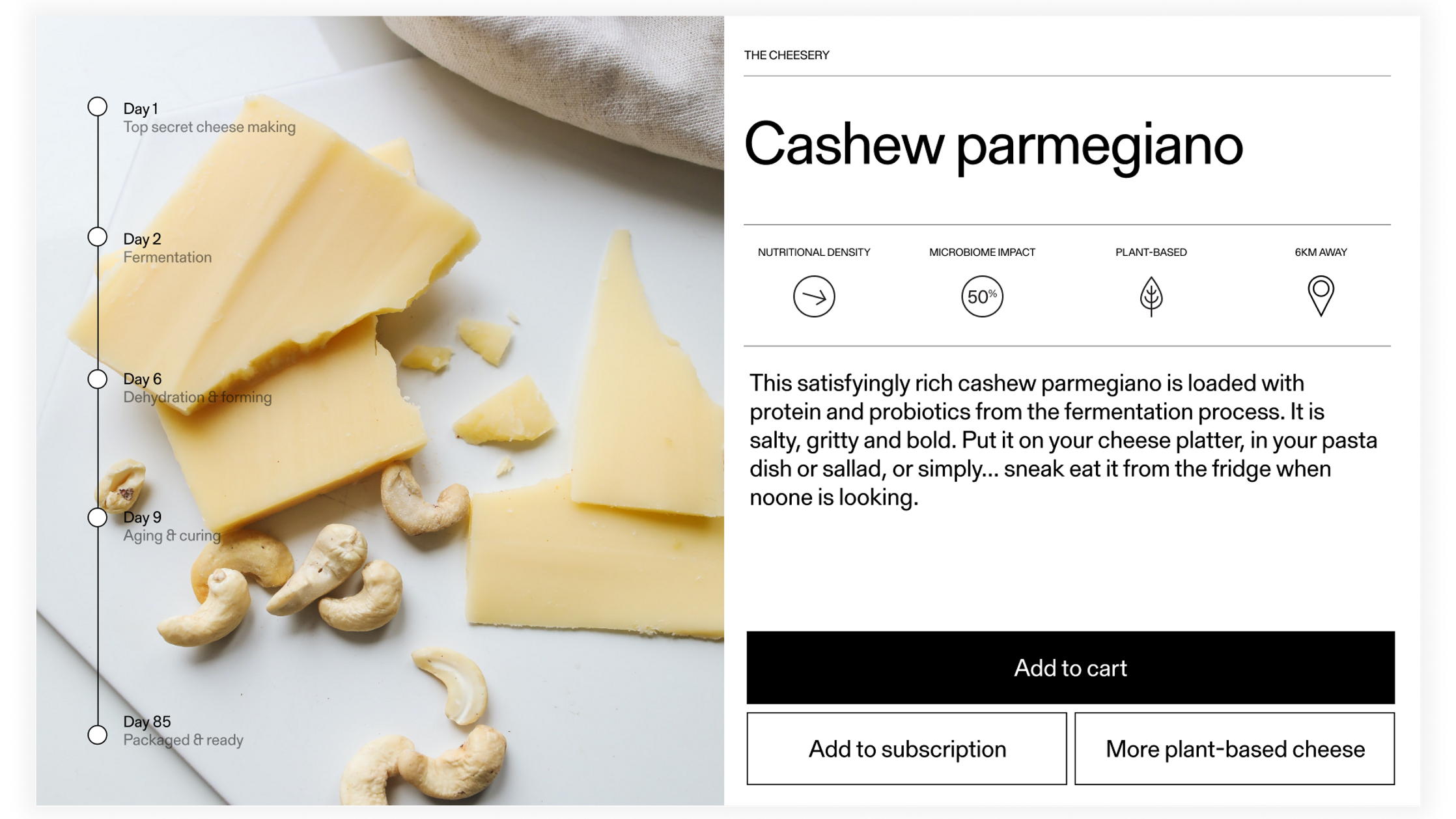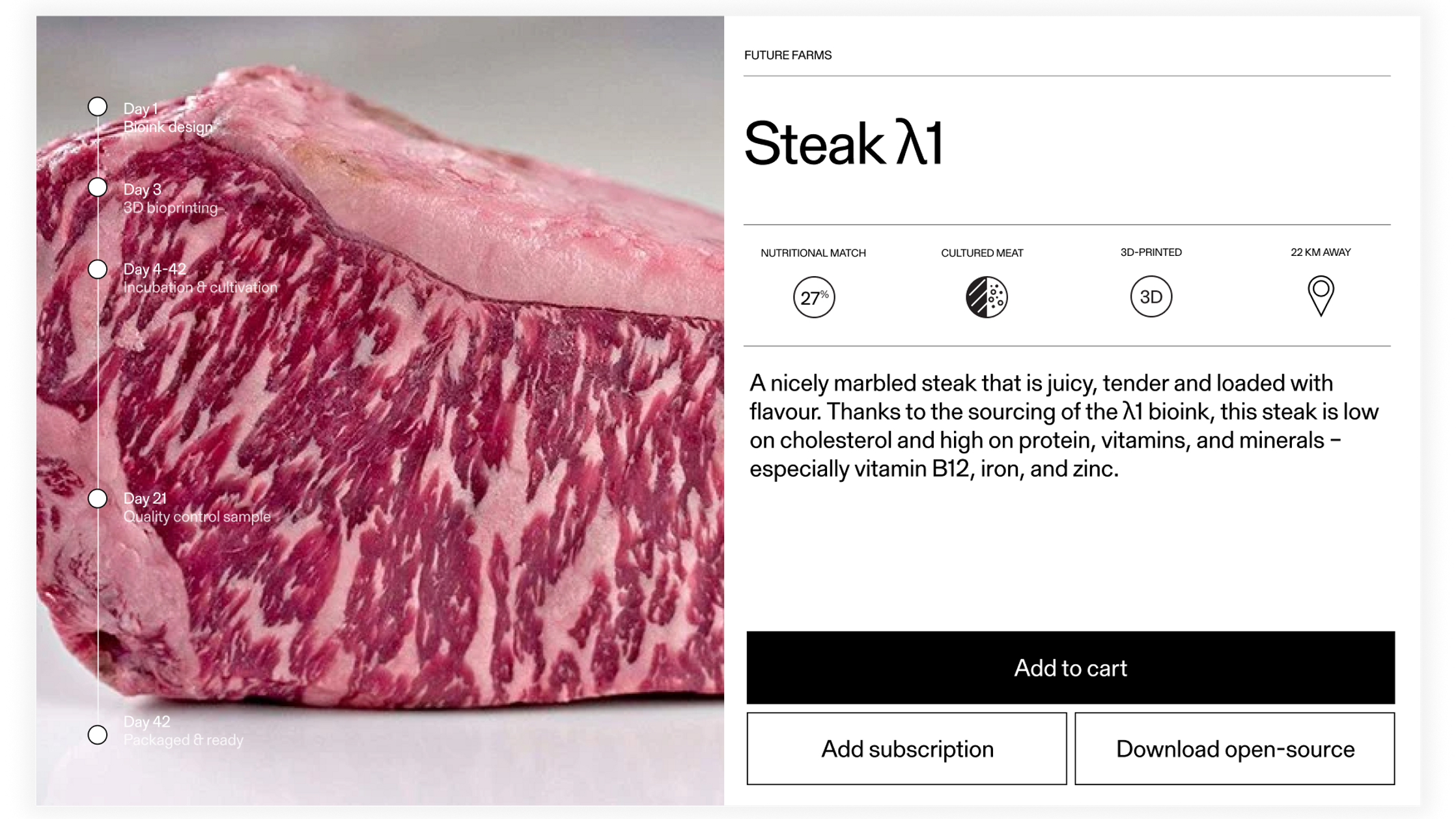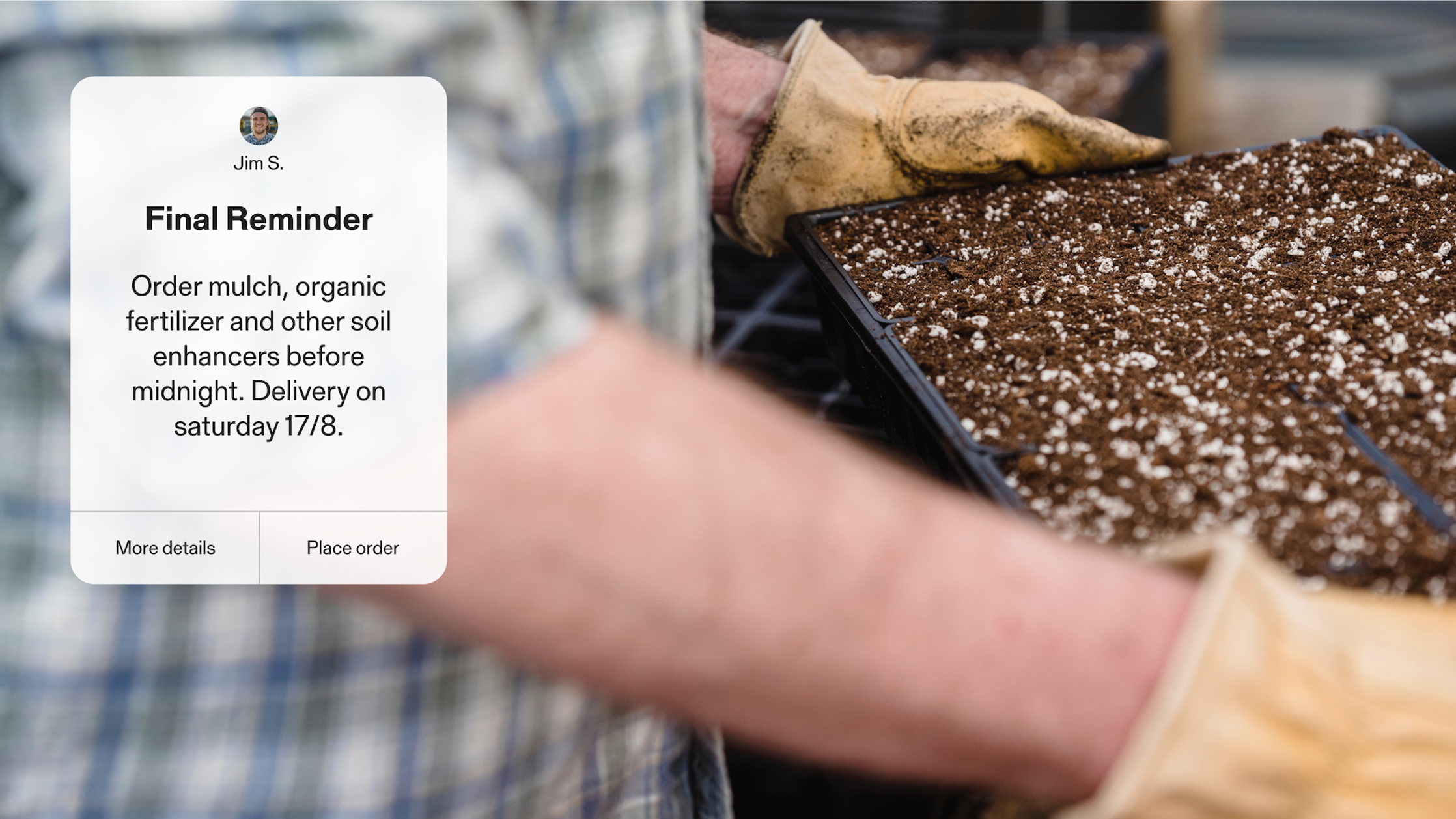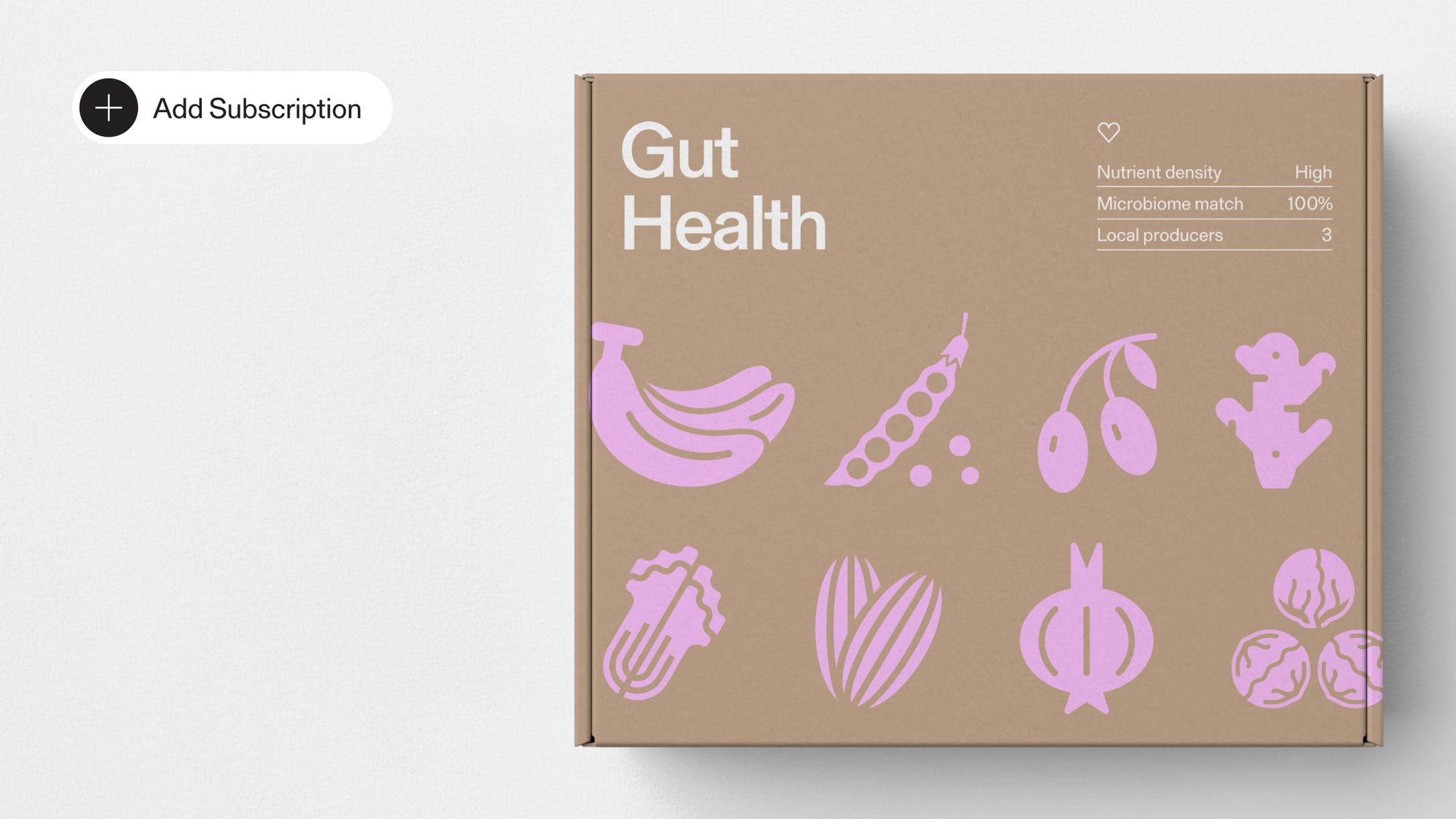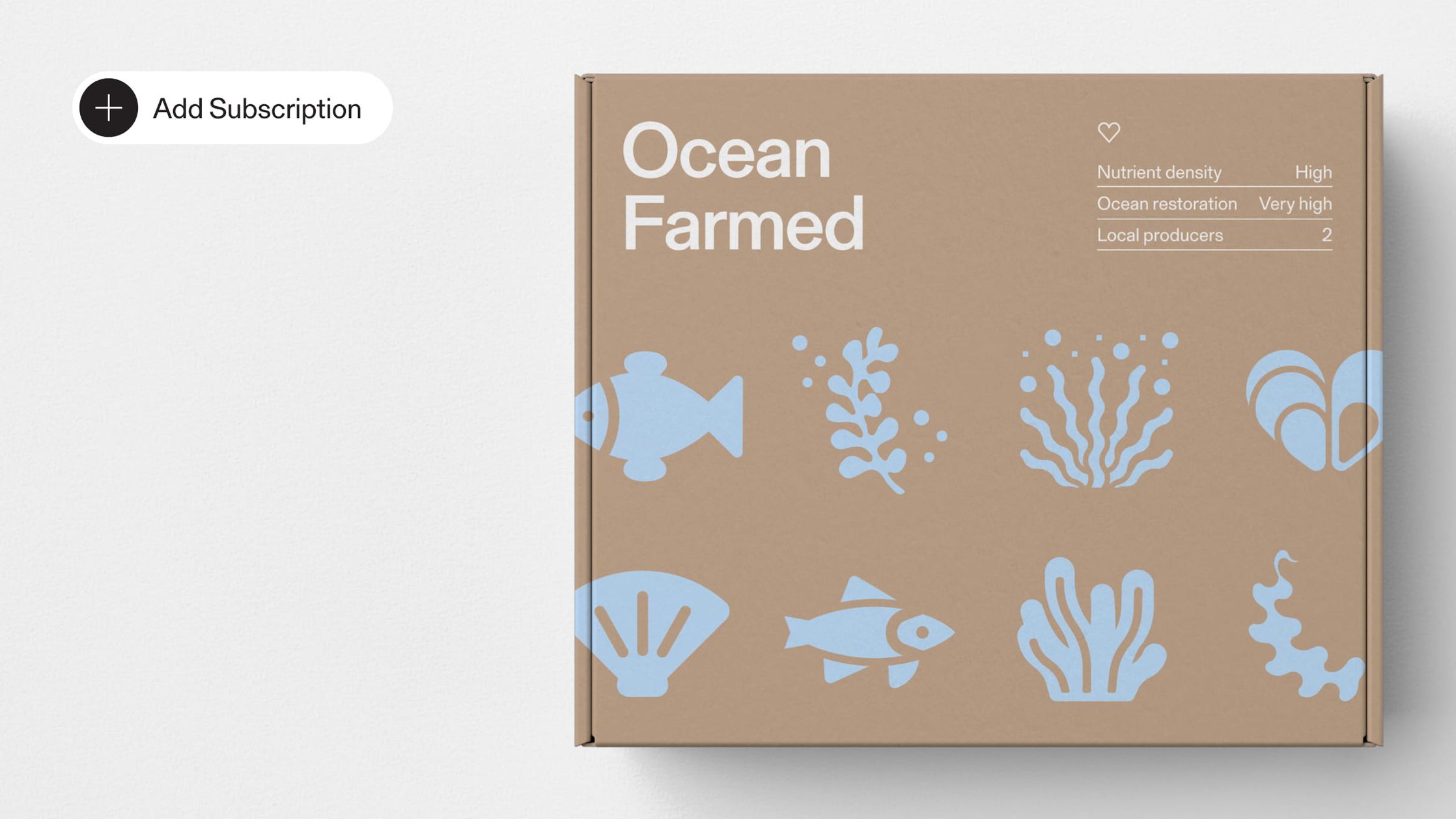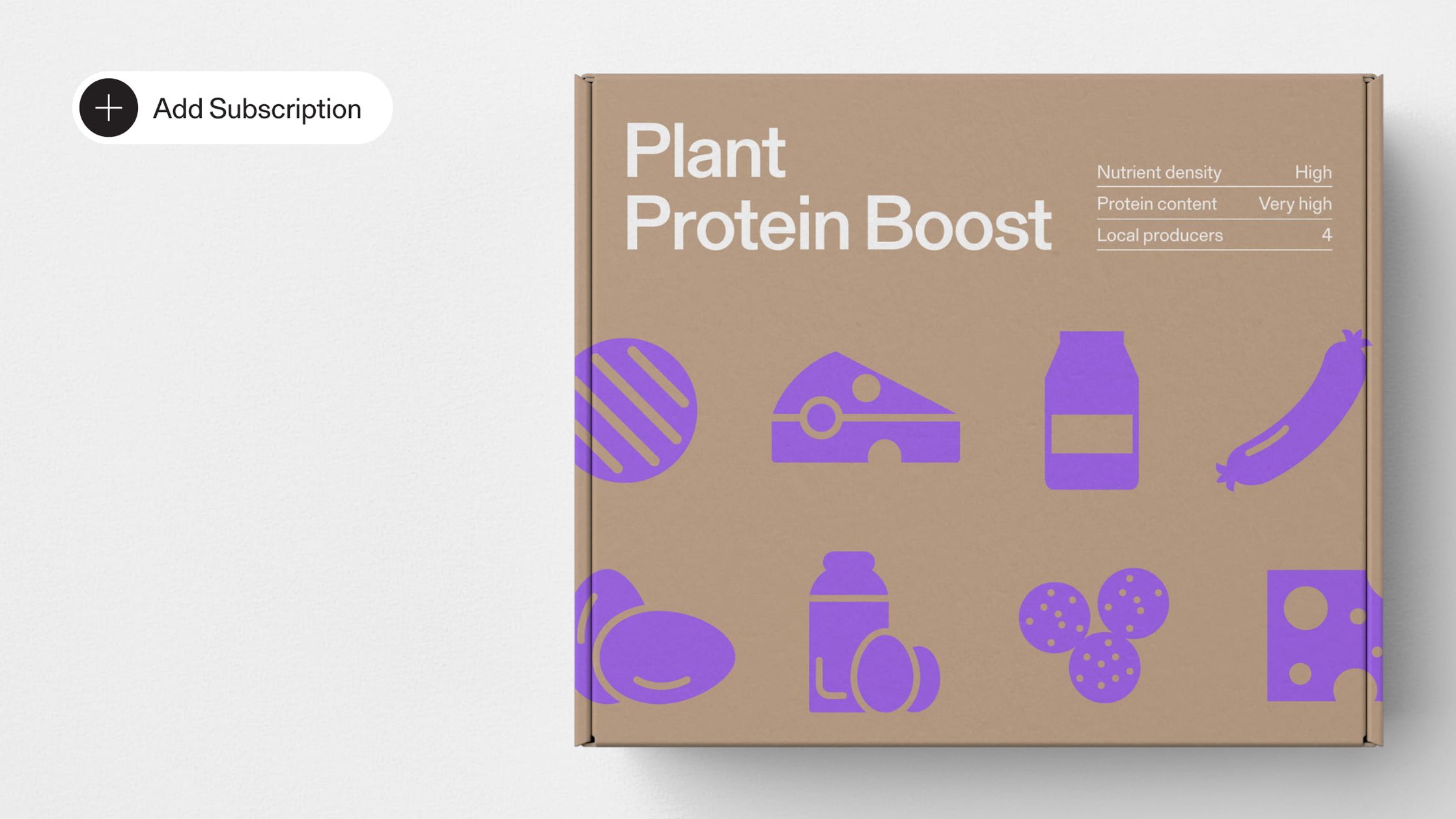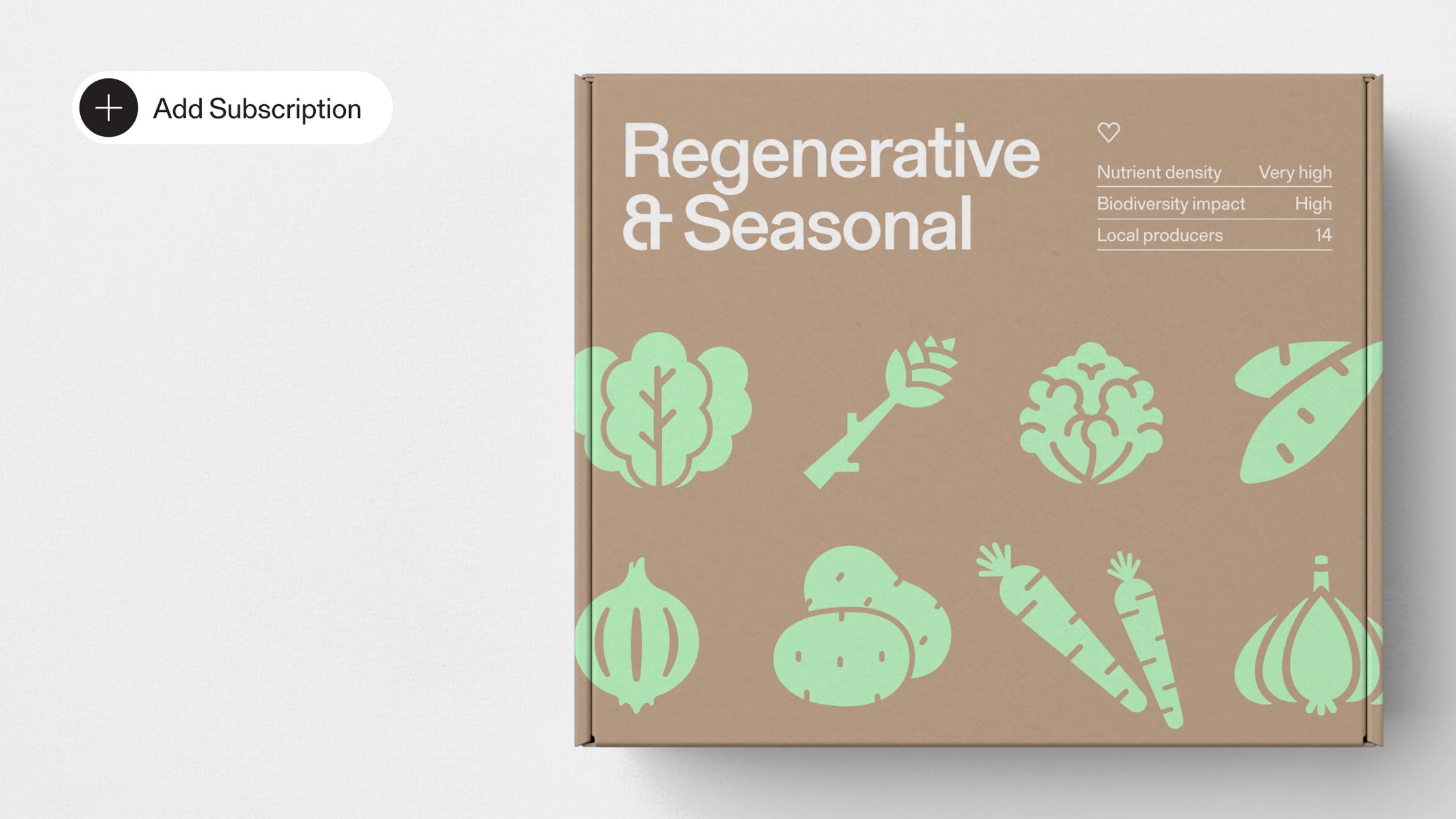Sally with EY Doberman
How did we get food so wrong?
One standardised tomato out of more than 5000 varieties
Billions of animals farmed in factories
A sea of mass-produced sameness
Perfectly shaped cucumbers in fossil plastic
Commodified, industrialised, far removed
Life.
Life.
When food is actually
With infinite varieties.
It’s time for things to shift.
Here’s our take on what an alternate future could look like — and how we got there.
This is a preferable future of food.
And interdependent eco-systems
in perfect symbiosis.
And interdependent eco-systems
in perfect symbiosis.
It’s time for things to shift.
This is a preferable future of food.
Here’s our take on what an alternate future could look like — and how we got there.
SALLY, EY Doberman’s future manifestation lab, brings to life an emerging system that has yet to come to fruition.
We manifest these preferable futures through the lens of digital products, services, and business models that could enable and accelerate key transformational shifts across business and society.
Let’s journey
We recognise that these three shifts are not the only ones needed — far from it. We have chosen them because we firmly believe they could unlock more far reaching transformation, and that they can be greatly accelerated through existing, scalable solutions.
One hour food system
In our future, industrialised global supply chains have become a thing of the past, and food circles are growing smaller. Instead, producers have direct connections to you and me, creating accountability and opportunities — changing the dynamics of the food system.
Even though the food system has gotten smaller, the variety is greater.
Rather than the global standard diet, we have thriving, diverse, and delicious local food economies.
No, local sourcing is not the only answer, but it is an opportunity yet to be sufficiently tapped. Large amounts of regeneratively grown food can come from within and close to where we live if we create a better and more equitable system.
Open marketplaces seamlessly connect local producers and consumers
In 2022, there was a structural power imbalance in the agri-food value chain — moving money and power to retailers and global agricultural companies. As a result, many farmers found it hard to sustain their livelihood from farming, and fewer still had the finances necessary to invest in better, more regenerative farming practices.
In addition, most people worldwide, especially in cities, were entirely disconnected from where their food came from. Those who wanted local food were often limited to a weekly farmers market. There was a great need to bring producers and food closer together.
A key barrier to change was that the retailers almost entirely controlled the means and channels for distribution. These amazingly effective systems that successfully fed billions of people had also created an unnecessary and profound chasm.
Today, vibrant local marketplaces connect local and regional producers with consumers. These open platforms allow consumers to buy and interact more directly with producers through an ecosystem of services, for instance, subscription, co-growing, and food-related experiences. The increased connection has led to an increased demand for regeneratively produced food.
Through intelligent, collaborative distribution networks and hubs, food products can move smoothly from different farmers and producers to the end customer. Food mileage is reduced. Regional food resilience is greater.
With fewer intermediaries, food producers get a higher margin for their products, making investing in sustainable production methods and technologies easier. In addition, smaller producers have an easier time making ends meet.
The platforms have also made it possible for farmers to diversify their income streams through selling experiences, knowledge, and refined products.
Enablers
These open local marketplace platforms result from different sectors taking action in this area.
Some pioneering retailers saw the public’s desire to access locally produced food and decided to invest in developing market platforms to tap that market opportunity. They also had the benefit of already having well-developed distribution capabilities.
Cities began collaborating around the notion of one-hour food systems — wanting to support regenerative and resilient food production on a regional level, recognising the need to create new contact points between producers and buyers. Many municipalities already had experience from building co-distribution centres and continued building on this asset.
In other places, new intermediaries sprung up, such as companies that wanted to connect quality-sensitive restaurants with local farmers and producers.
Technologically, these platforms have been more successful by using algorithms matching buyer preferences with locally available producers. When someone travels, they experience other one hour food systems, discovering local flavors and food cultures. It also helps inform what is produced from year to year.
The use of APIs between the digital tools and management systems that farmers use has made it painless to get valuable and accurate information into the marketplaces.
By virtue of being open, these platforms have truly empowered small producers to reach a broader market. Anyone can jack into these marketplaces as long as they get third-party verification as a trusted food producer.
Select pioneers 2022:
Expanding our understanding of the value and nutrition of food
The appearance of open digital marketplaces has connected people with producers and reconnected people with how food is grown and how precious it is.
Food is no longer the anonymous mystery it was in the early 2020s. Back then, most people had little contact with their food’s origin before picking it up on a supermarket shelf. More often than not, the origin was hidden from sight along with the sweat and toil of the men and women who nurtured it to life.
Today it is easier for people to appreciate the work that goes into bringing food to the market. The process has come alive through these platforms. The same can be said for seasonality, which is much easier to relate to within one-hour food systems.
There is a greater focus on the nutritional differences between food from regenerative agriculture and large-scale industrial fast agriculture. We have broadened our focus from a few rough metrics around calories, carbs, proteins, and fat to a broader understanding of nutritional density, how food impacts our gut and immune systems, and beyond.
It would be inaccurate to say that these marketplace platforms simply connect producers and consumers. The whole story is that these platforms make it effortless for people to access locally produced and delicious fresh foods that are nutritionally matched to the needs of the individual.
Creating B2B symbiosis where waste is turned into value
Industrial symbiosis used to be a well known, but a rarely practiced concept
Many found the idea intriguing but not enough to pursue it in their businesess. It was simply too cumbersome, difficult, and different from normal waste handling and procurement practices. Producing and getting rid of waste was just a regular part of the business.
That is different today as many facilitated marketplaces for waste and side streams exist. These platforms make additional resource flows visible and broker the contact between supply and demand through data-driven mapping.
These systems provide a means for organisations to get paid for what was previously considered waste. At the same time, buyers can access cheap resources for their operations. Many platforms also help measure the environmental benefits of this increased symbiosis.
Select pioneers 2022:
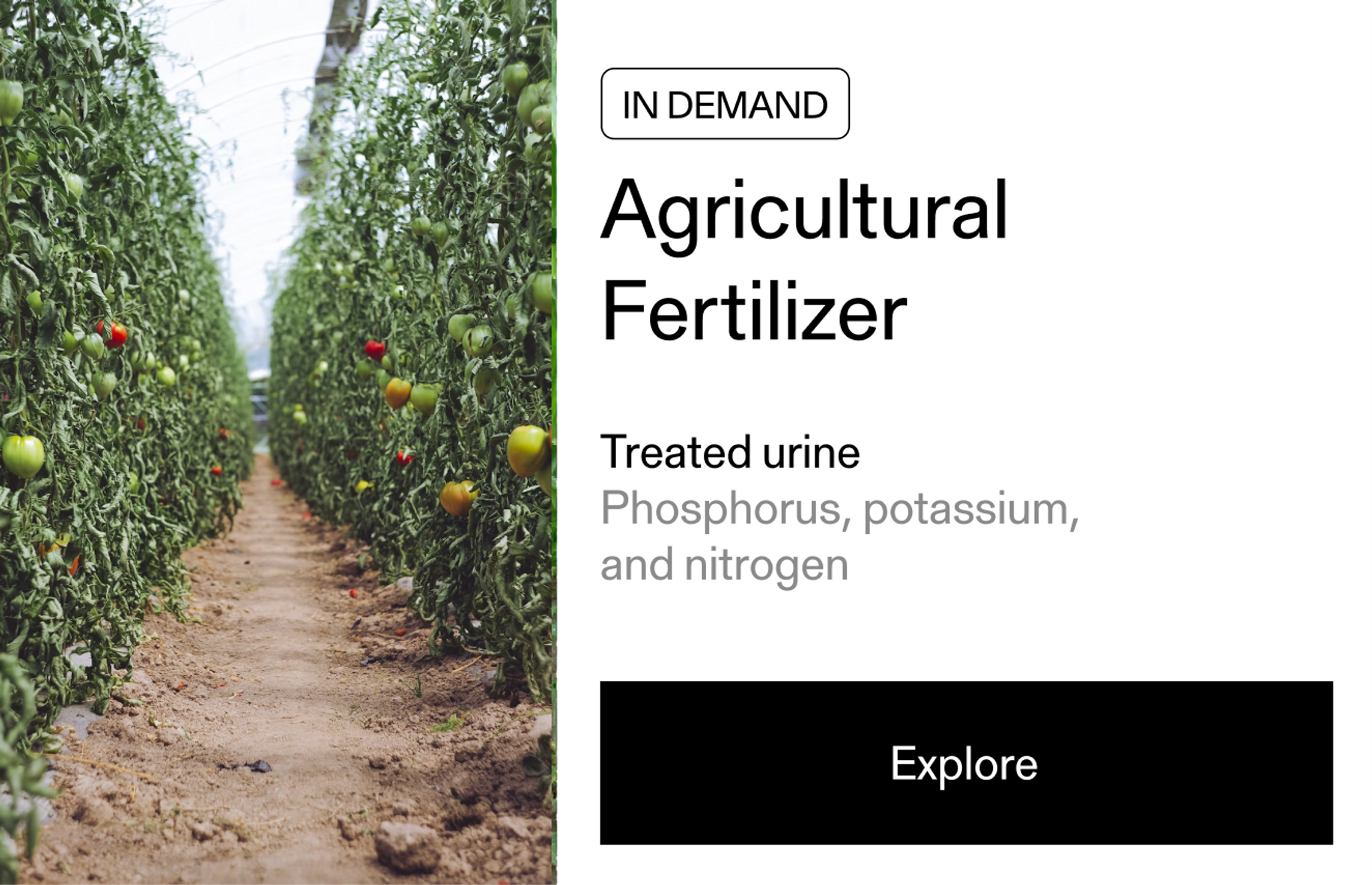
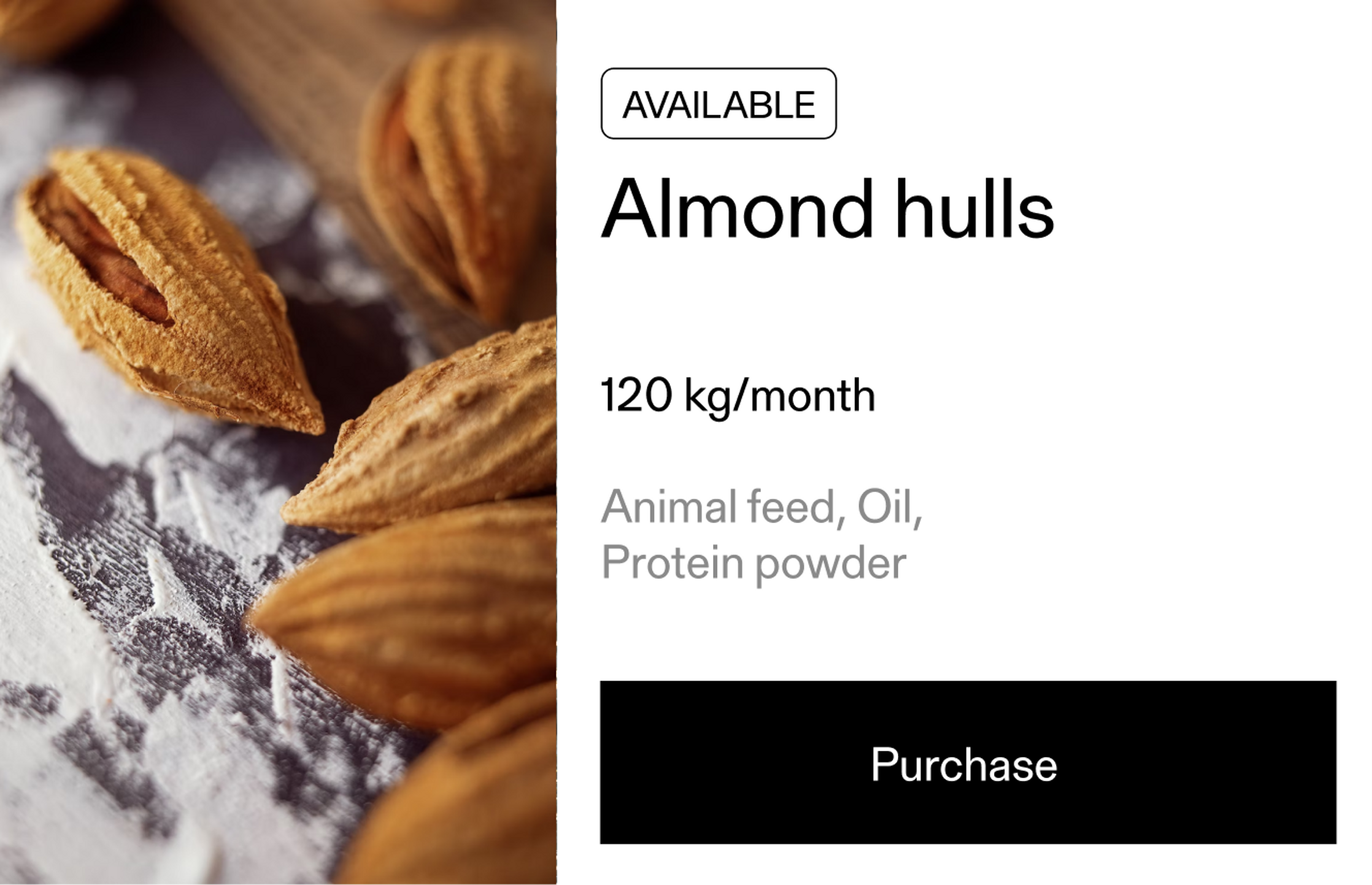
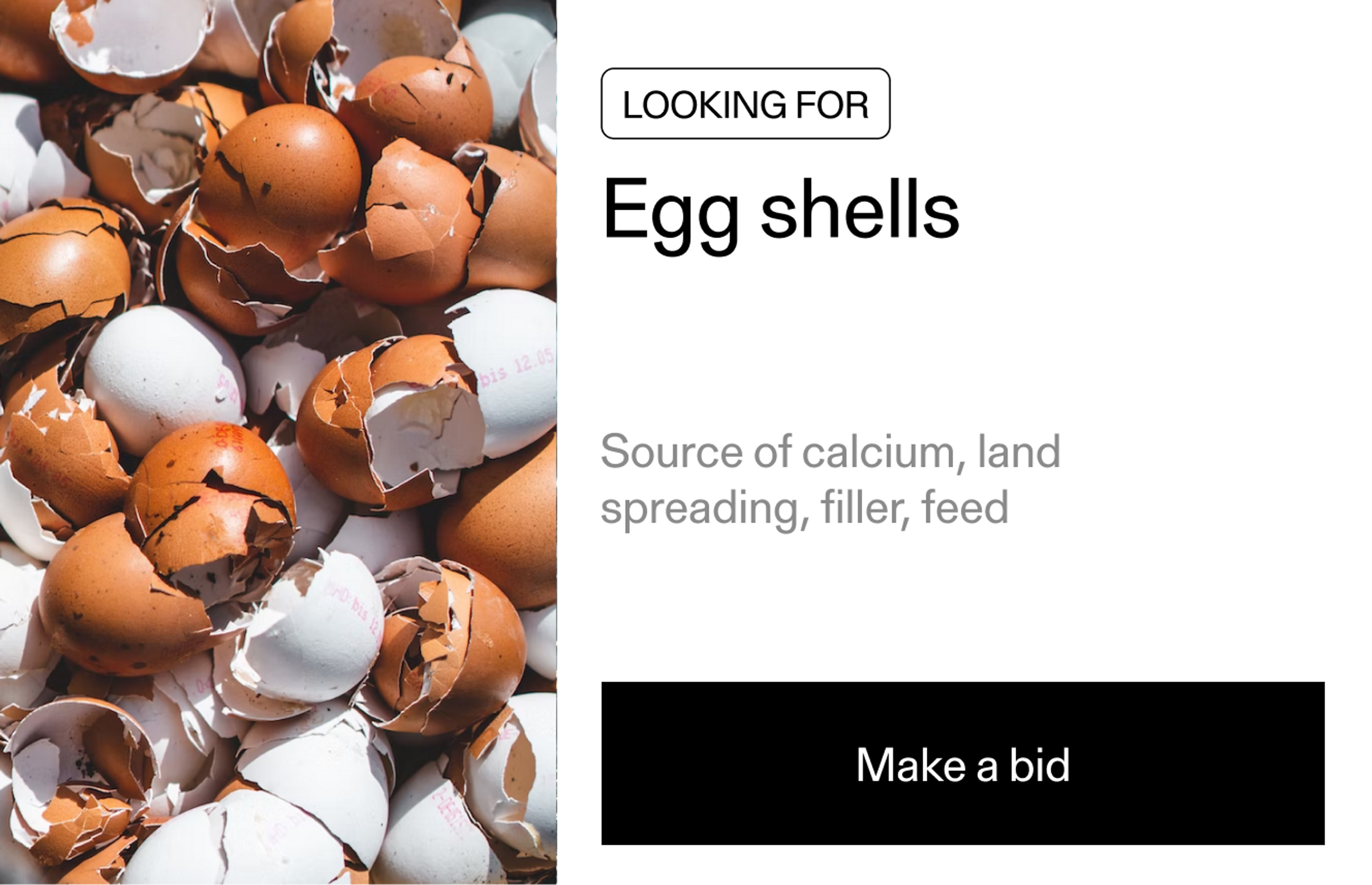
Select pioneers 2022:
Community food revolution
An expansion in urban food production is bringing food closer to people, and people closer to each other. Enhancing communities. Enriching city life.
Today, most of us grow some type of food at home — it’s as common as having house plants.
Dinner guests bring kale or carrots, rather than a bouquet.
And new jobs and businesses are booming, from community farmers to urban food planners.
For practical reasons —scarcity of space, the high value of urban land, the density of cities— urban food production is unlikely to bring more than 10-25% of the volumes needed to feed a growing population. That is, however, not insignificant and it could also improve wellbeing and quality of urban life, stregthen and reviltalise communities, and bring back our appreciation for food.

An expansion in urban food production is bringing food closer to people, and people closer to each other. Enhancing communities. Enriching city life.
For practical reasons —scarcity of space, the high value of urban land, the density of cities— urban food production is unlikely to bring more than 10-25% of the volumes needed to feed a growing population. That is, however, not insignificant and it could also improve wellbeing and quality of urban life, stregthen and reviltalise communities, and bring back our appreciation for food.
Community food revolution
And new jobs and businesses are booming, from community farmers to urban food planners.
Dinner guests bring kale or carrots, rather than a bouquet.
Today, most of us grow some type of food at home — it’s as common as having house plants.

Data-driven urban planning is revealing spaces and synergies for food production
Following the food crisis that ensued from the COVID-19 pandemic, the Russia-Ukrainian war, and several years of low-yield harvests across the globe, more and more regions, cities, and municipalities developed and enacted urban farming action plans.
As this movement grew, so did the need for better tools for planning and decision-making. As a result, new consortiums of cities, tech companies, academia, and entrepreneurs came together to take action.
Today there are suites of professional tools that help guide decision-making and identify urban farming opportunities. Many of these tools use cross-data analytics to identify underutilised spaces used for food production.
A tool might, for example, identify rooftops or ground-level space that would be suitable for different types of farming — making intelligent suggestions about the most significant opportunities and how to proceed. By cross-referencing with data sources that could map thermal and CO₂-emission hotspots in the city, the tool might also suggest how to utilize those heat and CO₂ sources as resources. Finally, by cross-referencing socio-economic and crime mapping data, the platform might propose suitable locations for community gardens to cultivate social capital, not only food. These tools drastically speed up the rate at which cities could expand their urban farming programs.
Enablers
New standards for safely sharing data between systems and open APIs that connect different data sources have made these tools possible.
The progress in digitalising old data repositories has also been meaningful. For instance, most old building construction drawings that used to sit in analog city planning archives are now digital — making it possible to do an automatic structural analysis of rooftops using machine learning. We can now identify their approximate load-bearing capacity and suitability for different types of rooftop farming.
The Open Cities Platform became a global accelerator of the development of these tools. As a result, different cities and sectors started sharing their code, working together to make rapid technological leaps possible.
Select pioneers 2022:
A range of smart services has democratised farming
Urban farming used to be for the dedicated few. The hardcore enthusiasts. The nerds.
Beyond having some herbs on your kitchen counter or leisurely growing veggies in your garden (if you were fortunate enough to have one), urban farming at a large scale required more than most people were willing to invest. It took too much time, effort, money, and research at a limited success rate.
Little food came from within our cities, and our gardens remained lawn-covered biological deserts. Balconies and terraces had only a few decorative flower pots, and companies were only considering the possibility of growing food if it was their core business idea.
But a series of nested food crises in the early 2020s led a lot of sectors to look at how they could scale urban farming. So when companies and municipalities started launching these tools and services that reduced the effort needed and the learning curve, a large audience was eager to receive them.
Today, everything has changed. Cities produce more and more of our food. The whole process from start to finish has become a lot easier and requires less interest, time, and money. And it is enabled by a new ecosystem of services and tools that allows everyone to produce food.
Enablers
The development of these tools was aided by progress in data processing, analytics, and technologies such as AR and machine learning — making it possible to put the intelligence and experience of experts into the hands of city people who desire to grow food.
AR apps now help people envision and dream of what food production could look like for them — whether they have a garden, a rooftop terrace, a balcony, or an indoor space. It helps people foresee the amount of food they can produce and manage and reduce the amount of work necessary for success. These apps also help people acquire the tools needed and gain professional support.
Personalized tracking and management tools also track all tasks throughout the year, including how to take care of harvests.
A host of full-range service providers have popped up, growing food in gardens and properties where the owners have little interest, time, or competence to do it themselves. It has accelerated the amount of regenerative food produced locally and has given home and property owners a way to profit — in veggies or money.
Select pioneers 2022:
Food is reviving, reconnecting and strengthening our communities
We didn’t see it at first — the obvious connection. Most of us were not used to having the kind of buzz and activity in our neighborhoods that urban farming would bring. We were hanging out in our gardens and balconies, often exchanging niceties with our closest neighbors. There was a limited amount of community spirit in many of our communities.
That is one of the most notable differences today. Urban farming has brought people out and closer together, strengthening our social capital. We’re not only growing vegetables — we’re growing people and relationships.
Enablers
The increased sense of community has come from many converging forces.
In many places, the shift started as professional urban farmers began to lease and rent land in privately owned gardens for small-plot intensive farming. These farmers were genuinely interested in building good relationships with people in the neighborhoods where they operated, and many enjoyed their presence and started to farm more.
Municipalities and cities started implementing neighborhood-level infrastructure to support the growing interest in urban farming. These physical hubs, such as self-service storage containers, made it easier for people to engage in urban agriculture. They reduced the need to own everything and made composting, mulch, tools and knowledge, more readily available. The physical hubs also became natural meeting points for people.
As interest and focus on urban farming grew, social media platforms started paying more attention to these growing peer-to-peer networks. Soon, features and entire applications began popping up, catering directly to this movement’s needs, helping connect people to share and trade things, skills, time, and a sense of community.
Select pioneers 2022:
And, a new micro-brewery movement is revolutionising proteins & fats
In the early 2020s’ venture capital poured into food tech companies focusing on fermentation and precision fermentation technologies. Soon, bioreactors and other equipment prices dropped, allowing regular people to play around with these technologies.
Foodies started up small fermentation microbreweries, experimenting with new proteins, algae- and fungi-based foods, no cow dairy products, and 3D-printing of food — bringing new culinary experiences to the world. Discussion forums were alive and vivid. They were eager to learn, experiment, and share their learning with others.
In parallel, global institutions like the UN and the WHO started exploring how fermentation tech can feed the many and empower poor communities to produce their food. These efforts gained support from academia and tech companies — providing brain power and money to support the efforts.
Online discussion forums soon turned into open-source databases where these different worlds of food-as-software met to share their progress and help each other.
Select pioneers 2022:

The impact plate
Technology is unlocking a new paradigm of health and environmental consciousness in eating — helping people break old habits and establish new.
Today, we expect the full story of the food on our plates
Aligning what we eat with the health of our bodies and the planet that sustains us
Our understanding of the effects of food on our health is less than 1%, and the planetary impacts are equally complex. We recognise that unveiling those patterns will take decades — if we ever fully understand them. However, turning already existing and emerging data into actionable insights for people would profoundly impact health, well-being, and the planet.
Our understanding of the effects of food on our health is less than 1%, and the planetary impacts are equally complex. We recognise that unveiling those patterns will take decades — if we ever fully understand them. However, turning already existing and emerging data into actionable insights for people would profoundly impact health, well-being, and the planet.
Aligning what we eat with the health of our bodies and the planet that sustains us
Today, we expect the full story of the food on our plates

AI-supported tools are revealing the true impact of what we eat
It used to take a lot of personal effort to eat sustainably and healthily. For a lot of people, it led to eating less well and planet-friendly than they wanted to.
Today, AI-supported tools gather vast amounts of data about the sustainability and health impacts of what we eat and put this information at our fingertips in the form of actionable insights. Open APIs make data available wherever food is purchased: restaurants, grocery stores, marketplaces, and online vendors.
Powerful machine learning algorithms, image recognition, and AR are used to guide our thinking and decisions. From planning what to eat and point of purchase to the kitchen and the dinner table.
It is a form of data-driven nudging based on our personal preferences and needs. Helping to bring awareness and making better choices easy.
Select pioneers 2022:
Integrating a multitude of sources to enrich and reveal complex patterns
The tools that help people and families eat better pull data from various sources, ranging from academia and public health institutions to tech companies and actors throughout the food value chain.
The foundation for these unprecedented levels of data access is a set of open APIs and collaborative algorithms that were started by food industry actors and later mandated by governments. Through these APIs and algorithms, cutting-edge data around food’s environmental, social, and health impacts, as well as nutritional composition, has become more readily available — making it easier to develop intelligent tools for consumers.
Another vital source of information that enables personalisation is data related to the individual and their desires, preferences, and health needs. This involves data around personal taste, medical records, blood tests, and gut microbiome tests.
Sensor technologies and hyperspectral imaging technologies used in farming also provide highly reliable data about the nutritional composition of food.
Third-party transparency and supply-chain tracking have become the norm. It touches every part of the physical supply chain — from seed to peel.
Select pioneers 2022:
Personalised services makes better habits delicious and effortless
In 2022, many people lived with a guilty conscience about their eating, feeling that they should eat differently but not truly managing to shift their habits. There were simply too many barriers.
Today, there are personalised services that make new cooking and eating habits effortless and fun.
For example, box subscriptions compile fresh foods from different producers within the one-hour food system to suit the specific health needs, tastes, and conditions of the customer and their families. So it’s easy to get superb food for the feast and time-pressed everyday life.
Boxes can be matched against nutritional data, special needs, and preferences and adjusted over time through feedback loops. Subscriptions can even be matched to personal calendars to anticipate special events or predict when family members are away.
Smart responsive recipes use the waste from the previous day and provide interactive libraries for cook-along, plating, and collaborative improvements.
Select pioneers 2022:
Yes, the challenges facing the food system are great. But our imaginations are greater.
Together, we can change the story and build a preferable future.
Rich with diversity, community, nutrition, and deliciousness.
A world where food is life.


ABOUT
The future is determined by our actions and inactions we take today, but we can’t build what we can’t imagine.
SALLY depicts preferable futures to help manifest something painfully on its’ way but yet to come to fruition. Using the lens of digital products, services, and business models, we make these futures concrete and tangible to reduce the pain and increase the speed of change.
SALLY is EY Doberman’s future manifestation lab.
